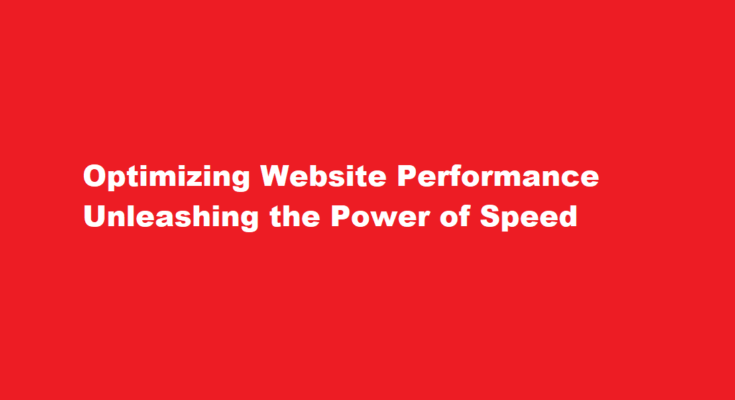Introduction
In today’s digital world, where user experience is paramount, website performance plays a pivotal role in attracting and retaining visitors. A well-optimized website not only enhances user satisfaction but also improves search engine rankings and conversion rates. In this article, we will explore key strategies to optimize website performance, making it faster, more efficient, and ultimately, more successful.
Minimize HTTP Requests
One of the primary factors affecting website speed is the number of HTTP requests made when a user visits a page. To minimize these requests, combine multiple CSS and JavaScript files into fewer, larger files. Additionally, leverage CSS sprites to reduce the number of image requests. These optimizations can significantly improve load times and boost overall performance.
Optimize Images
Images are an integral part of web design, but they can also be resource-intensive if not properly optimized. Compress images without sacrificing quality using tools like ImageMagick or TinyPNG. Moreover, consider using responsive images, which adjust their size based on the user’s device, further reducing load times for mobile users.
Enable Browser Caching
Leveraging browser caching is a simple yet effective way to enhance website performance. By instructing the user’s browser to store static assets like images, CSS, and JavaScript files, subsequent visits to your website will be quicker as the browser will retrieve these assets from the cache rather than re-downloading them.
Implement Content Delivery Networks (CDNs)
CDNs distribute your website’s static content across multiple servers worldwide, bringing the data closer to users and reducing latency. This geographical proximity allows for faster data delivery and ensures a seamless user experience regardless of the user’s location.
Minify CSS, JavaScript, and HTML
Minification is the process of removing unnecessary characters (whitespace, comments, etc.) from CSS, JavaScript, and HTML files. This reduces their file size, leading to faster loading times. Several online tools and plugins are available to automate this process, making it easy to implement on your website.
Opt for Asynchronous Loading
When loading JavaScript, consider using the “async” or “defer” attribute, allowing the browser to load the script without blocking the rendering of the page. This can lead to a significant improvement in perceived load times and overall website performance.
Prioritize Above-the-Fold Content
Above-the-fold content refers to the portion of a web page that is visible without scrolling. Optimize this content to load first, focusing on crucial elements such as headings, primary images, and important calls-to-action. This ensures users can access essential information quickly, even if the rest of the page takes longer to load.
Monitor and Analyze Performance
Continuous monitoring and analysis of website performance are essential for identifying bottlenecks and areas that require improvement. Utilize tools like Google Analytics, Lighthouse, and PageSpeed Insights to gain insights into load times, user behavior, and performance metrics. With this data, you can make informed decisions to further optimize your website.
Optimize for Mobile Devices
With an increasing number of users accessing websites on mobile devices, optimizing for mobile performance is paramount. Implement responsive design principles to adapt your website to different screen sizes, and prioritize mobile-specific optimizations like smaller image sizes and touch-friendly elements.
Choose the Right Web Hosting
Selecting the right web hosting provider can significantly impact website performance. Opt for hosting plans that offer sufficient resources and reliable server infrastructure. Consider using dedicated servers or Virtual Private Servers (VPS) for better performance compared to shared hosting.
Reduce Redirects
Redirects, while useful for website maintenance, can add unnecessary overhead to page load times. Minimize the number of redirects on your website, and whenever possible, update links directly to the new destination to ensure a seamless user experience.
FREQUENTLY ASKED QUESTIONS
What affects website performance?
This means that loading a web page takes longer than before. There are several factors that affect website speed. These include the number of files being loaded, the size of those files, and the server response time, etc.
What makes a website run smoothly?
To get faster download speeds, you should use a fast, lightweight theme for your site. This is because you want a website theme that will download quickly for your visitors when they visit your site. Poorly coded themes are “heavier” and take longer to load, particularly on mobile devices.
Conclusion
In the fast-paced digital landscape, optimizing website performance is not a luxury but a necessity. A faster website leads to improved user satisfaction, higher search engine rankings, and increased conversion rates. By following the strategies outlined in this article, such as reducing HTTP requests, optimizing images, enabling browser caching, and leveraging CDNs, you can unleash the true power of speed and set your website on a path to success. Regularly monitor performance metrics and adapt to changing trends to ensure your website remains optimized and at the cutting edge of user experience.
Read Also : Mastering Microsoft Excel A Comprehensive Guide for Beginners



